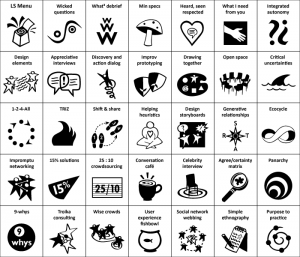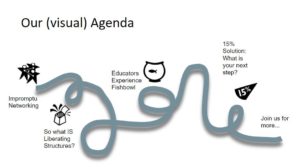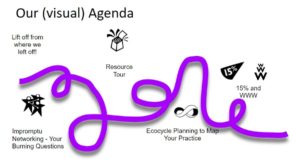 Liberating Structures has become central to my practice over the years. I have dabble with using LS online, but the call to do more online is getting stronger, particularly in introducing people to LS and getting immediately to hands on use. I wanted to share some 90 minute “studios” that I have been facilitating in different contexts to introduce LS in the domain context of the participants. In other words, the examples here may be in education, the approach can work with any domain simply by changing the invitations used with the structures. Also, I’ve used the studio approach face to face and it really works well. I’ll write that up another time!
Liberating Structures has become central to my practice over the years. I have dabble with using LS online, but the call to do more online is getting stronger, particularly in introducing people to LS and getting immediately to hands on use. I wanted to share some 90 minute “studios” that I have been facilitating in different contexts to introduce LS in the domain context of the participants. In other words, the examples here may be in education, the approach can work with any domain simply by changing the invitations used with the structures. Also, I’ve used the studio approach face to face and it really works well. I’ll write that up another time!
Why 90 minute studios?
First, the term “studio” comes from the UdGAgora, work a team of us, led by Tanis Morgan of JIBC, with the University of Guadalajara on increasing learner engagement. It was structured as a participatory, hands on online and offline learning experience around the idea of a studio where content is only introduced, and the learning is focused on execution or use of the content. (More of our work with UdG here.) A studio also conjures up the space of an artist, and in many ways, the use of Liberating Structures is a form of social artistry. And yes, I like the term.
Second, the experience shared here recaps what we did at the e/Merge Africa Festival of Learning online event in July, hosted by, among others, the amazing Tony Carr from University of Capetown.
90 minutes is a useful length of time online. It is just on the edge of “too much time” in terms of participant attention, and it is long enough to get an introduction to the content and use 2-3 structures applied to that group’s real domain/needs. Face to face, you can get 3 or even 4 structures in a 90 minute segment, but our experience is that things take longer online due to acclimatization to technology (in our case, Zoom) and the subtleties of converting a process to online.
Multiple 90 minute studios can be scheduled over time. Right now 3 rounds of studios seems to build enough traction for people to begin experimenting with and adopting LS into their practice, but I have not done a rigorous follow up. That would be a wonderful experiment. AND, you can do a stand alone studio – absolutely!
Studio “Strings”
Liberating Structures are often used in a sequence called a “string.” What follows are some different strings for studios, options and my rationale behind each string.
Studio 1 – What is Liberating Structures and Why Should I Care?
 Purpose: Provide just enough experience with and information about LS so that participants want to try it and/or learn more. It’s like that yummy food sample in the market that draws you in.
Purpose: Provide just enough experience with and information about LS so that participants want to try it and/or learn more. It’s like that yummy food sample in the market that draws you in.
- Impromptu Networking in pairs or 1-2-4-All to immediately demonstrate how distribution of power (in this case to everyone in pairs) can change interaction, particularly online where we have been “presented to” to death! Debrief by showing the LS microstructures underneath Impromptu Networking/1-2-4-All and transition into…
- Brief introduction to LS (slides and chat) to get the fundamentals visible. (An example here of slides for three studios in the education domain.)
- Users Experience Fishbowl to hear from real practitioners in the domain share the good, the bad and the ugly of using LS in their work. What is great about doing this online is you can tap into practitioners anywhere which is super powerful.
- 15% Solutions to get participants to think about something they can do with what they learned NOW.
- Point to resources and, if appropriate, future studio opportunities.
Studio 2: Real Application of Liberating Structures
 Purpose: Use LS to do something real in the domain of the participants that gets results in 90 minutes.
Purpose: Use LS to do something real in the domain of the participants that gets results in 90 minutes.
In the application studio, we find someone in the organization/group/network domain who has a real need or challenge and we design a string of LS for them to use in addressing that need. The practitioner(s) are in the center and the other participants are essentially watching a coached design session. Note: this session always seems too short, but I hesitate to go to 2 hours!
- Something to “lift off from where we left off” from the first studio. A fun way is to get the practitioners to briefly share their challenge, then have the whole group do some creative destruction to make way for innovation with TRIZ .
- Next we get to the issues. The team shares their challenge with options like Celebrity Interview using Purpose to Practice and Matchmaker for draft string. I notice that we blur the boundary between structures as we get intensely into design. The other participants are in “watching mode” but also able to contribute via chat. We have everyone NOT on the design team turn off their cameras in this phase.
- What, So What, Now What with everyone to debrief, re-point to resources, microstructures, LS values and invite for session #3 as appropriate. Sometimes if we need to close rapidly and lost our debrief time, I close with “Just Three Words” (10 mins)
String 3: Diving Deeper into Liberating Structures
 Purpose: Peel back enough layers to reveal the basic structure of LS, some related complexity theory and show that there are many layers of value in using LS.
Purpose: Peel back enough layers to reveal the basic structure of LS, some related complexity theory and show that there are many layers of value in using LS.
The intention behind this studio was for people who attended #1 and #2. What often happens is we get new folks, so you need to be attentive to give at least a little context at the front end. The string should be very flexible and often I use the beginning of this studio to find out what people want to try and do, and then wrap the explanation and theory around it.
- Reset Context/Liftoff with Impromptu Networking around burning questions, or What, So What, Now What? This can be very rich in pairs or triads. From the results, we choose what structure to do next.
- Discuss user groups, the LS Slack, immersion workshops, website, book, app and other resources.
- Do an Ecocycle on our LS practices (or other domain related topic) to expose people to one of the richer but (in my opinion) harder to initially grasp LS.
- And complete with 15% Solutions to stimulate follow up, action and behavior change. For example, if this was with a team working on learning and diffusion, we would explore the next opportunity they needed to unleash and engage people in the work, and what LS they might try. If we skip Ecocycle, I love doing 15% Solutions and then Troika Consulting to use peer input to deepen and refine an idea.
Implications of LS online
All of the Liberating Structures mentioned above have been successfully and repeatedly done online. We are still experimenting with other LS. They do require the type of break out room capability that Zoom has. The use of video cameras really enhances the process – and sometimes people don’t have cameras, or even microphones, so make sure that is addressed in your preparations. There are certainly some particular tips about doing these structures online, but that will have to wait for a later post!
Resources and Examples
Recordings and artifacts from the e/Merge series on LS for Increasing Online Learning Engagement in July, 2018.
- Session 1 Recording: https://calpoly.zoom.us/recording/share/Setle1omPEopi_x67krupFI_U5tXaFxeBa2G4ecoLZ6wIumekTziMw
- Session 2 Recording: https://calpoly.zoom.us/recording/share/8tjf8m6bbiNr6sEd51HTvvYBHjLTlA_y5wB-tQHA6zawIumekTziMw
- Session 3 recording: https://calpoly.zoom.us/recording/share/cI59OBQNE2ibI1m-6jTP2RMTT454DPyk7h2WVIQkIsywIumekTziMw
- Slides from all three sessions: https://docs.google.com/presentation/d/1ebVBkKDbXjguhDRoZHZ9PEV_lyAmaANkPMkV8ZSTcRs/edit#slide=id.g3ce42f6c42_0_1236
I just love what you are doing in the world, Nancy. And thanks for sharing!
Thanks for sharing Nancy. I’m doing virtual LS too & finding that they’re transforming the old style conference calls! I love how you’ve done the virtual agendas.